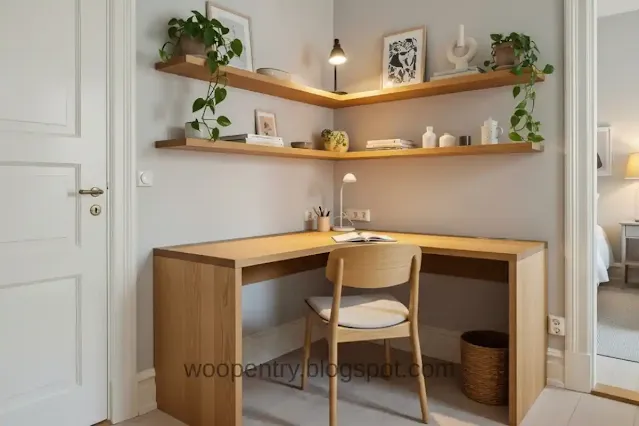Maximizing Corners: Creative Wooden Desk Ideas for Awkward Spaces
 |
| Maximizing Corners: Creative Wooden Desk Ideas for Awkward Spaces |
Small living spaces—whether it's a studio apartment, a tiny home, or a compact bedroom—often come with architectural quirks. Odd corners, sloped ceilings, alcoves, or narrow walls can feel like wasted space. But with the right creativity and a smart wooden desk design, these awkward areas can become highly functional workspaces. This article explores innovative wooden desk ideas specifically designed for those tricky corners, helping you unlock their potential without compromising on style or usability.
Maximizing Corners
- Understanding the Awkward Space
Before choosing a desk, it's important to assess the nature of your awkward area. Is it a triangular corner? A recessed alcove? A space beneath a staircase or window? Measure dimensions carefully and take note of lighting, outlet placement, and visibility from other parts of the room. Once you understand the layout, you can select or customize a wooden desk that perfectly fits.
One of the most efficient ways to utilize a sharp or empty corner is to install a custom wooden corner desk. Unlike bulky rectangular desks, L-shaped or triangular desks are designed to snugly fit into a 90-degree corner, turning dead space into a productive hub.
For a warm, natural look, opt for solid oak, maple, or reclaimed wood finishes. Add floating shelves above the desk to enhance storage without cluttering the desktop. This setup is ideal for laptops, writing tasks, or crafting, and doesn’t interrupt the visual flow of the room.
If floor space is tight, a wall-mounted corner desk is an excellent solution. These floating wooden desks attach directly to the wall and leave the floor clear, giving the illusion of more room while offering sufficient surface area for light work.
Choose clean-lined wood slabs in light tones like ash or birch to keep things airy. Add a minimalist chair or stool that tucks under the desk when not in use. You can also install a wall-mounted lamp or sconce to free up valuable desktop space.
Alcoves are often created by architectural features such as chimneys, closets, or room dividers. Instead of leaving them empty or just placing shelves, consider turning the nook into a mini office with a fitted wooden desk.
A simple wooden slab cut to size can sit across the width of the alcove. Choose warm-toned finishes to make the space feel inviting and cozy. Use the side walls to hang storage pockets, hooks, or organizers. For renters, a freestanding slim desk might also fit well.
Have a low window or ledge in your small room? Consider transforming it into a desk area. A wooden plank secured just beneath the window creates a functional workstation with a natural light advantage.
Use water-resistant sealed wood such as teak, especially if the window is often open. Add side storage with vertical organizers or a narrow set of drawers. A window nook
desk can double as a vanity or reading area when not in use.
- Under-the-Stairs Desk Setups
For duplex apartments or homes with staircases, the space underneath is often underutilized. A custom-built wooden desk designed to fit beneath the stairs can turn that void into a smart workstation.
Use the varying height to install open shelves or even hidden drawers. Walnut or darker wood finishes give a library-like charm, while lighter woods keep it modern and fresh. Be sure to integrate lighting to compensate for the typically shadowy placement.
Attics, lofts, or top-floor rooms often have slanted ceilings, which can make traditional
desk placement difficult. A low-profile wooden desk placed against the lowest part of the slope can make that space usable.
Choose a minimalist bench-style desk made of soft pine or bamboo. Install pendant lighting or LED strips along the slope to improve brightness. Use floor cushions or a low ergonomic stool to match the desk height.
- Narrow Wall-Mounted Workstations
For ultra-narrow wall spaces, even just a few feet wide, consider installing a fold-down wooden workstation. These small desks can be tucked away when not in use and are perfect for tiny homes, hallways, or bedroom corners.
Look for models with magnetic boards, chalkboards, or storage slots inside. When folded up, they resemble cabinets or decor pieces. Use reclaimed wood for character or sleek birch for a clean aesthetic.
- Multi-Level Desks for Tight Spots
In awkward layouts, multi-level wooden desks can maximize every inch. These desks feature tiered surfaces for different functions—writing, placing a monitor, storing supplies, or showcasing decor.
These are best custom-built or modular. Maple and ash woods are great choices for this purpose due to their durability and light appearance. Vertical pegboards or grids can be added above for tools and notes.
Hidden Pull-Out Desks
One of the most space-saving solutions for awkward areas is a hidden pull-out desk. These
desks are built into cabinetry, bookshelves, or even wardrobes, and slide out only when needed.
Ideal for minimalist interiors, these desks are typically crafted from matching wood tones to blend in seamlessly. Perfect for occasional use like laptop work, they’re also a great way to keep your home tidy.
Conclusion
Awkward corners and irregular spaces shouldn’t limit your ability to create a functional workspace. With smart design and the beauty of wooden materials, you can transform even the most neglected areas into efficient, stylish desks. From corner nooks to sloped ceilings and alcoves, there’s a solution for every tricky space. Whether you go the custom route or repurpose existing furniture, the key is creativity and precision.


